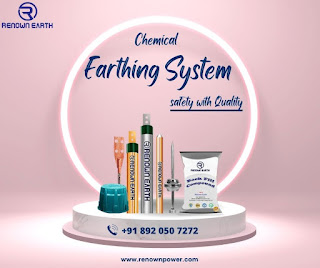Why GI Earthing Electrode for Substation is a Must?
An earthing is the technique of transmitting instantaneous discharge of electrical energy straight to the Earth via a low resistance connection. Electrical earthing is accomplished by attaching the current-less carrying section of the electronic or electrical devices or the supply system's neutral to the ground.
A chemical earthing electrode is a current transmitting element that is embedded directly in the ground, allowing fault currents to flow towards the earth. Substation systems are a collection of complicated metal-consolidated devices designed to reduce high voltage energy. Because of this, substation structures are typically located outside in open areas with only a sliver of shadow protection, since they manage transmission flow.
The positioning of the substation systems in open areas exposes them to elements of nature regularly. Because the structures comprise metals, this causes corrosion. Because of the principal role of the substation construction, it is subjected to a high level of energy and heat exposure, which leads to corrosion.As a result, substation structures must have sufficient basic coating on their metal surfaces to function properly to resist corrosion. chemical earthing is a traditional earthing process in which chemical compounds are put into earthing pits to aid improve soil quality and reducing soil resistance. To reduce earthing resistance, chemicals are utilized in this earthing type. The galvanization method was used to devise the answer to this corrosion problem.
Galvanization: The most popular concept of the galvanizing process refers to the method that emphasizes the deposition of a coating layer to the metal's surface. Zinc and Iron are the most common metals used in the galvanization process (Zn). Galvanization is primarily used as a protective method to prevent rusting and, as a result, extend the useful life of the fastened metal section. When properly applied to a steel surface, zinc coatings provide two forms of protection: barrier protection and galvanic protection, which enhances the metal's lifespan by protecting it against corrosion.
How is Substation Galvanization Performed?
Substation galvanization is accomplished by immersing steel or iron sections of the substation in a bath of molten zinc. It typically adjusts temperatures in the molten zinc bath at roughly 840°F (449°C). When the zinc layer applied to the iron or steel of the substation's exterior is taken from the bath, it combines with oxygen present in the environment to generate (ZnO) zinc oxide. This zinc oxide then combines with carbon dioxide in the environment to generate (ZnCO3) zinc carbonate, a more condensed protective layer. This zinc carbonate emits a dull grayish layer that is fairly stable and sticks securely to the top of the substation's steel or iron.
Why is galvanizing earthing required for substation structures?
- Substation structures are always exposed to natural elements that result in corrosion effects on the metals that are used to develop the substation.
- Further, with the substation structure continuously functioning with energy resources the corrosion effect increases over time at a faster pace. Yet substations cannot be shut down because of the important transmission operational role it plays in managing energy.
- Further, the metals used to develop the substation are of huge cost and value and corrosion can cause decay of the metal over time resulting in a rise in maintenance cost. It is because of this reason it is extremely important to galvanize the substation structure.
- Since the galvanization process will prevent the substation structure from corrosion and also safeguard it financially from huge losses that may happen because of decay in such costly metals. This will allow substation structures to come across profound advantages.
- Galvanized Earthing is required to save from thunderstorms, lightning, and electric shock through overvoltage.
What does it perform?
Metals are protected against corrosion by exposing
them to natural elements. It lowers maintenance costs annually. It saves from mental
deterioration due to frequent energy transfer. It protects you against massive
financial losses caused by mental deterioration and corrosion. Galvanization is a
one-time investment that can protect for decades.
Earthing has become a fundamental prerequisite for surviving lightning without being injured. Earthing is sending a charge directly to the ground via low-impedance wire to get a rapid release of electrical energy. To provide the lowest resistance path for fault current leakage, a low impedance earthing cable is used. In India, installing an Earthing system is required to safeguard equipment and people from the defective current. Most decent earthing system kits may last up to a decade with little maintenance.
Resource Box: Renown Earth always has prioritized the production of high-quality earthing solutions. We never take shortcuts with product quality. It is well known in the marketplace as one of the leading chemical earthing manufacturer and suppliers. We believe in offering deliverables with the utmost care. Our efforts have been rewarded with positive comments. Our persistent dedication characterizes us to providing our clients with the best service possible.
Read more about our Lightning Protection systems by
downloading our catalog. Renown Earth is well-known for being one of the best
chemical earthing producers, always happy to help clients. Above all, you may
reach out to us by email or phone. You've come to the right place.
.jpg)



Comments
Post a Comment